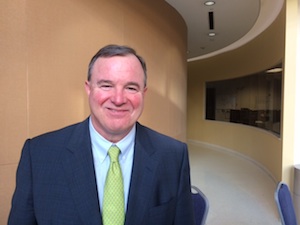
The audience had been warned of the risks of prefabrication, briefed about the complications of P3s and enlightened about recent studies whose author emphasized that contractors must avoid a growth-at-all-costs business model.
That’s when Timothy W. Triplett, the senior risk executive at Black & Veatch and a keynote speaker at ENR’s Risk & Compliance Summit on Sept. 30th at Georgia Tech in Atlanta, said that his company planned to expand its annual revenue from $3.5 billion to $7 billion by 2020.
At a required growth rate of around 20% to 22% per year, one audience member pointed out, the growth goal itself invites risk-taking.
Triplett, who is an attorney, is president of Black & Veatch’s legal and risk management division at a time when the company, once dominated by engineering services, performs more than half its work as a construction manager and contractor. He has helped put in place a detailed risk-management framework. It includes, for example, procedures to make sure higher-level review is made before any contract is accepted that carries liquidated damages. And to assure that higher-level managers stay involved with sensitive overseas projects and the problems they entail.
And while the various guidelines and reviews are carried out, Triplett said, Black & Veatch must be sure not to stifle the entrepreneurial energy that will be needed to reach the company's goals.
Growth and Decision-Making
Although the decision to proceed on certain projects should be made by both the operating divisions and corporate divisions in unison in light of the company's overall risk portfolio--that decision needs to be made in a way that, Triplett said, does not become an obstacle to the firm's growth.
"Our goal is not to see the Legal and Risk Management Division as telling our professionals what they can't do regarding a given project," said Triplett. "Rather, we want our group to be business partners with the operating divisions helping make each project successful."
A risk review panel, he said, "can't become some kind of gauntlet that people have to go through. We want it to be viewed as a resource."
Triplett sits on the company’s executive and executive review committee and last year he took over operational responsibility for the company’s business in the Middle East, too. Much of Black & Veatch’s planned growth must come from power-generation construction and contracts in the Middle East.
“We intend to grow on an international basis, which tends to be very challenged because some of the competition is subsidized, as well as having different legal and work cultures.”
Key Questions on Each Project
On each of its projects, Black & Veatch asks a series of questions: if it can work safely, provide unique value and bring the needed logistical tools of labor and subcontractor relations.
The company categorizes each type of project and keeps a close eye on how many of each type it has.
"You could say categorization of projects in terms of risk is not very scientific because it depends on so many factors for categorizing," Triplet told the audience of 125. "But over the years, we've developed a good idea of what projects run into trouble and why."
If something does happen, Triplett outlined the processes and procedures Black & Veatch has in place to with the problem quickly. "This allows us to see where our professionals can get involved on the project and try to solve any issues before they get larger. And, of course, this means managing our risk."
Another important question Black & Veatch asks is whether contract terms are suitable and what happens in the event of a dispute, including what country’s law will apply.
“We’re not in business of litigating lawsuits or making claims,” said Triplett. “But the farther we get from the headquarters flagpole, the more we have to be in a position where the contract is structured properly and the project is executed flawlessly. It's also essential that our upper management is involved with these projects and clients. This engagement must be at the beginning, middle and end of a project, fostering [client] relationships.”
Finally, said Triplett, Black & Veatch asks whether the project will create a sustainable market for the firm's services. While there are always first projects with new clients and markets, Triplett said, repeat business is far preferable to a one-off and positions the company to meet its aggressive growth targets.


Post a comment to this article
Report Abusive Comment